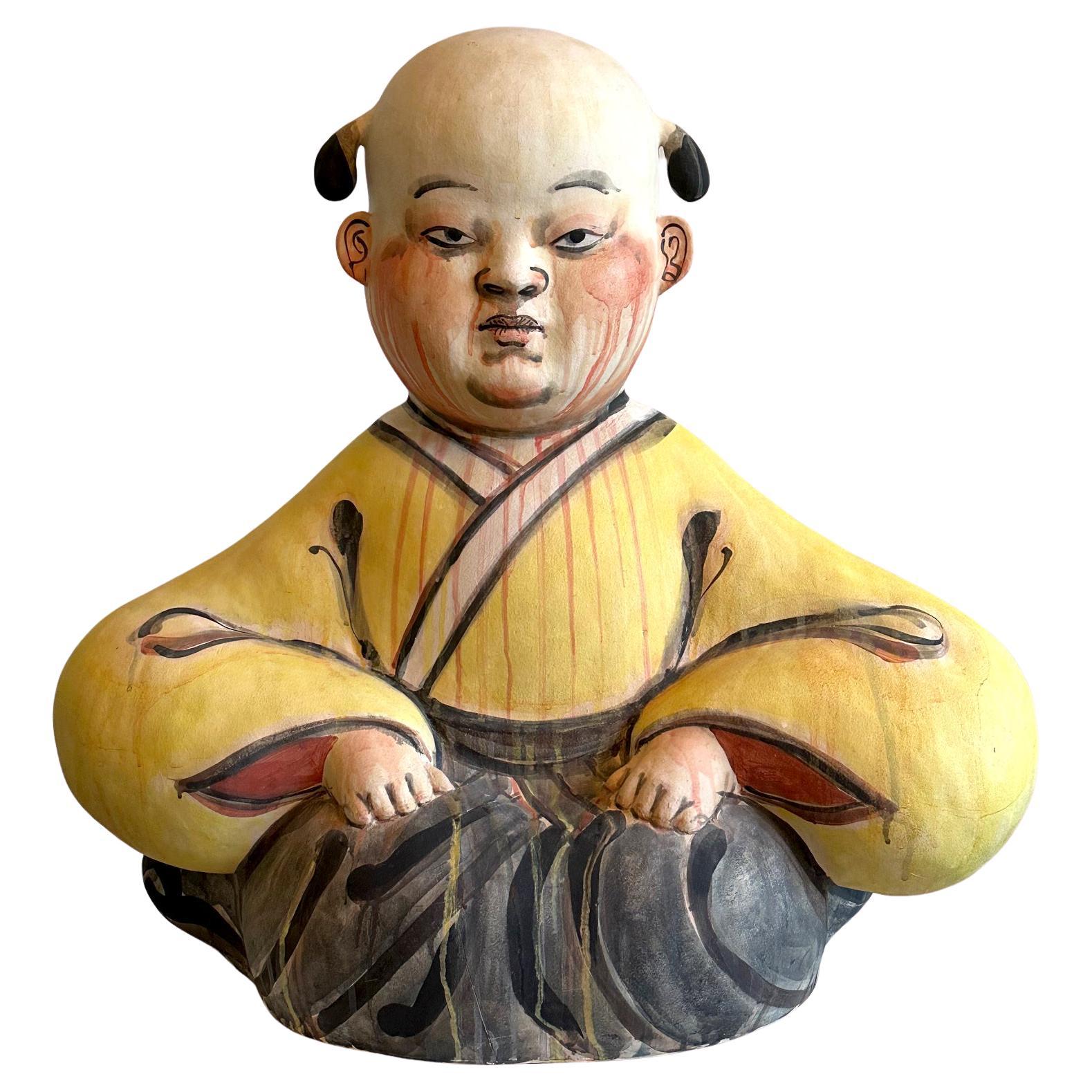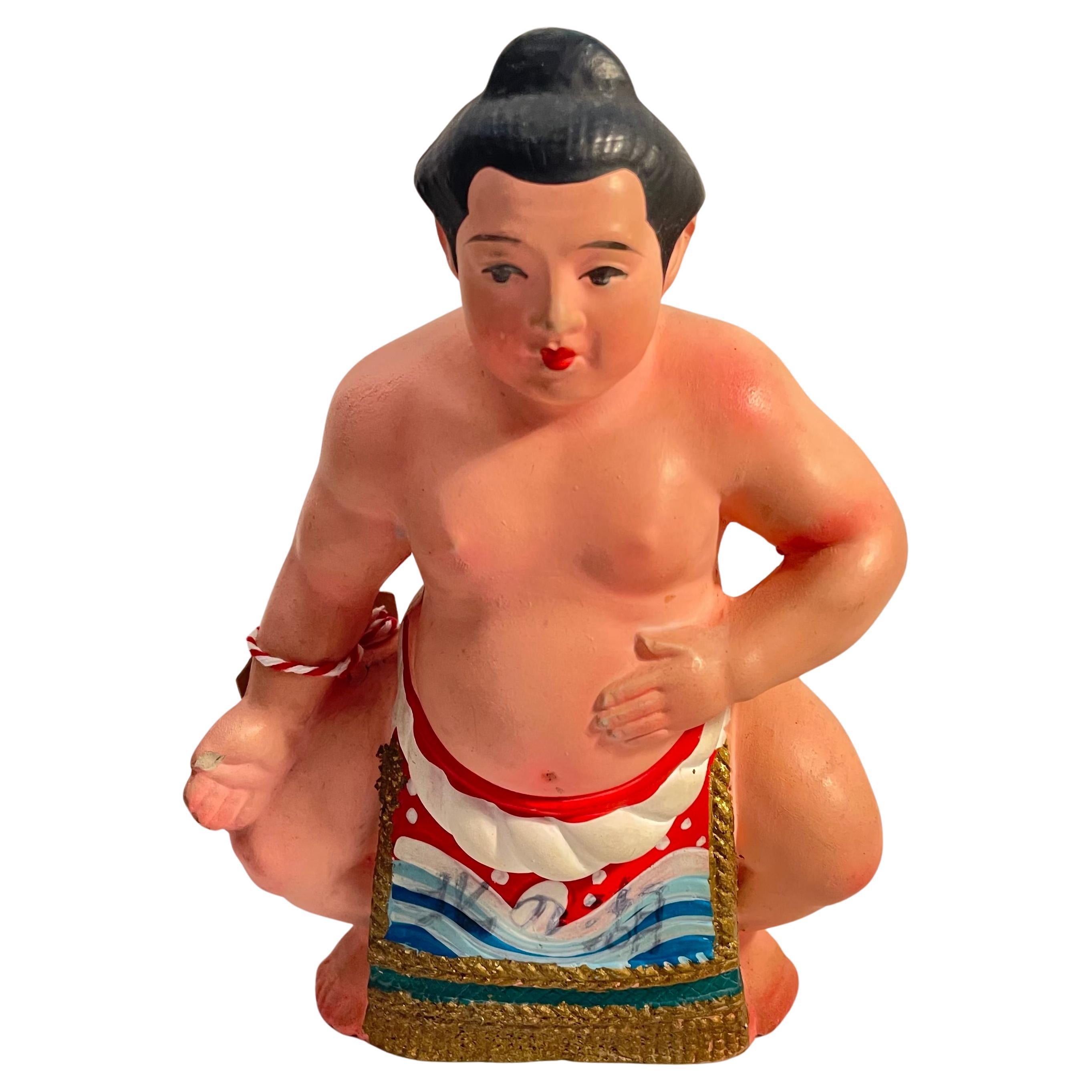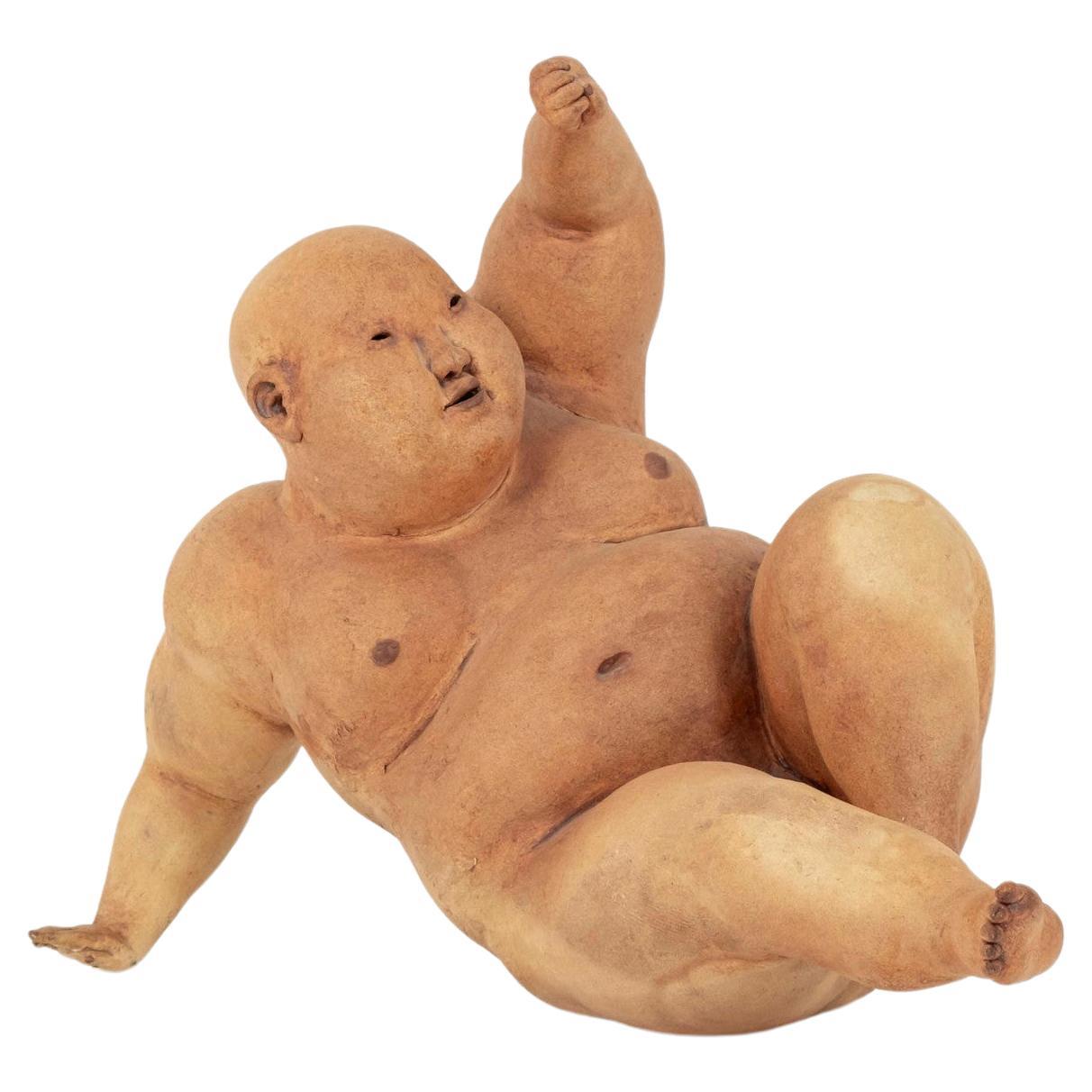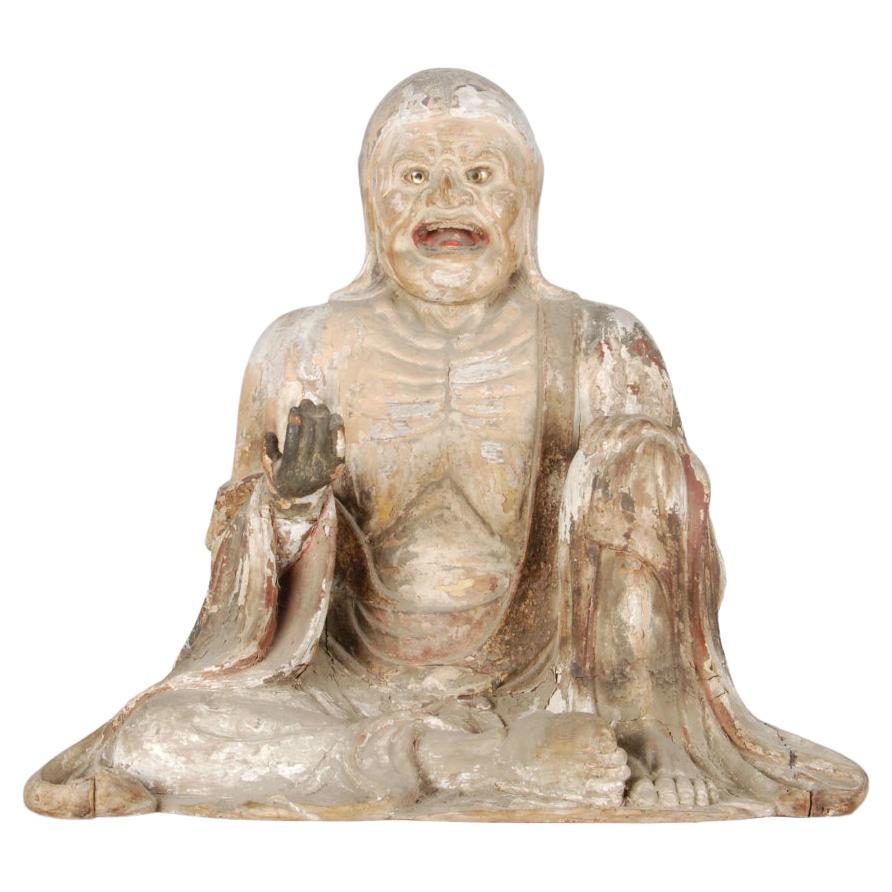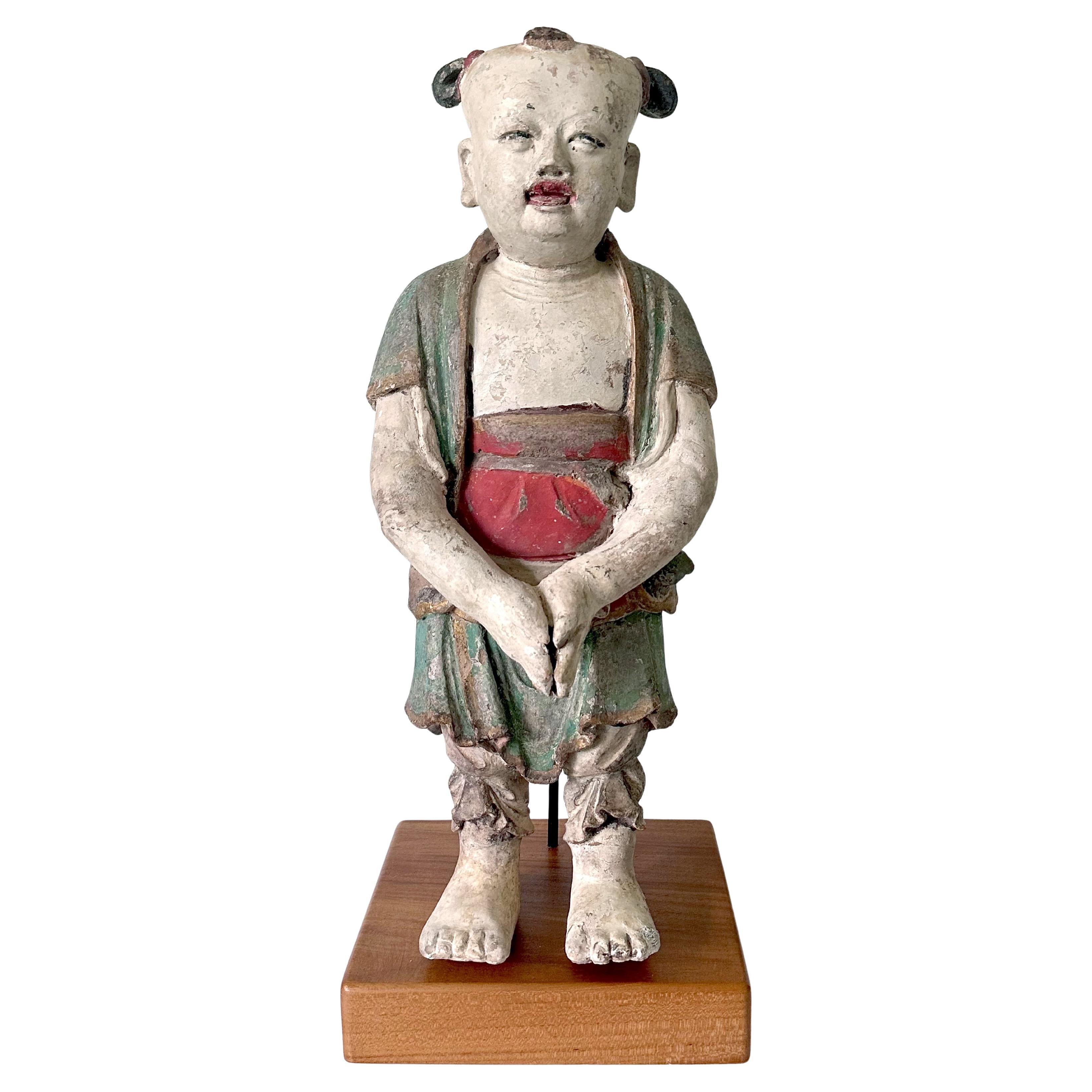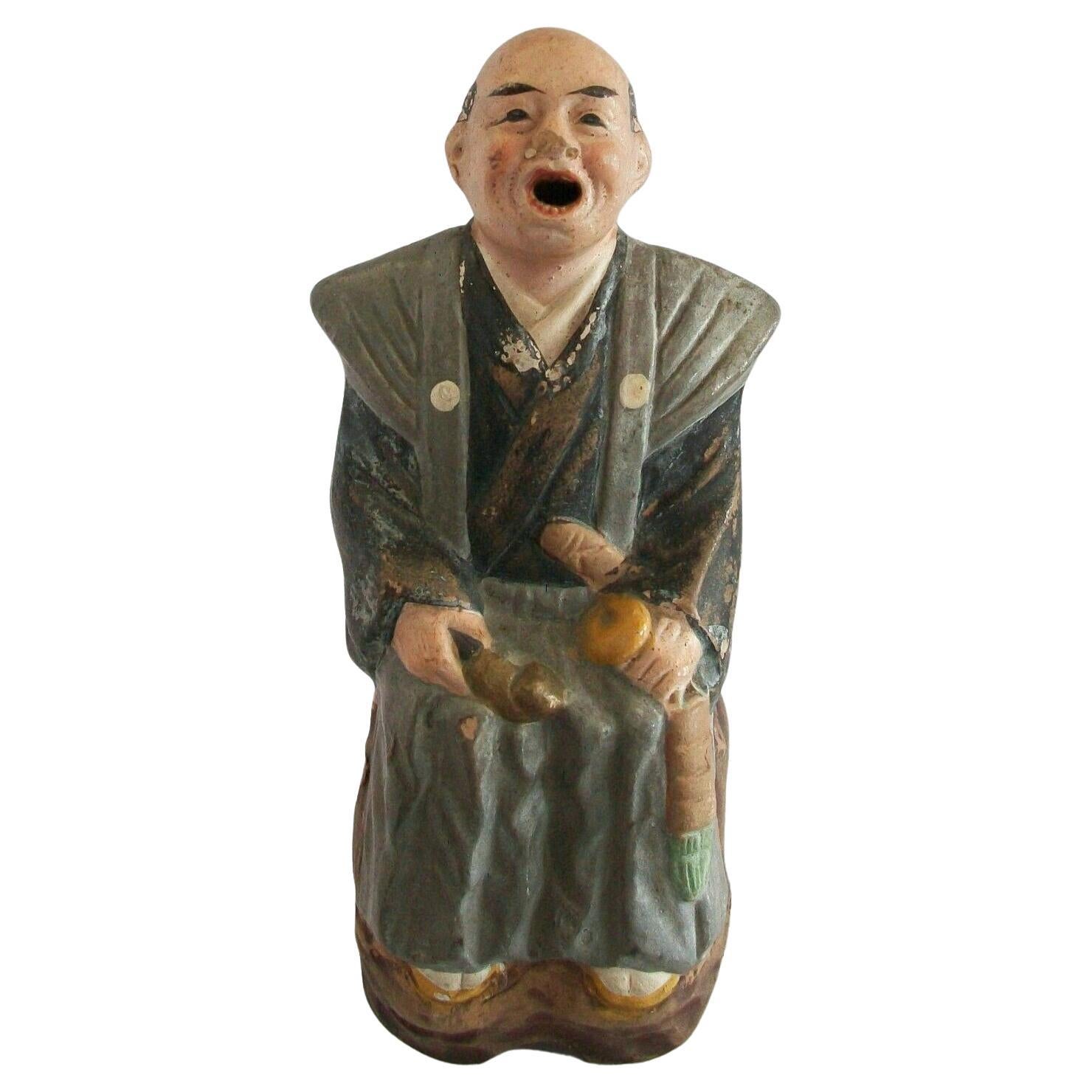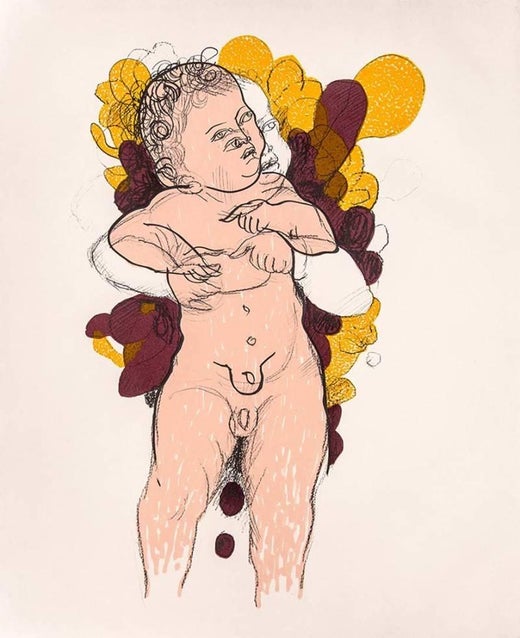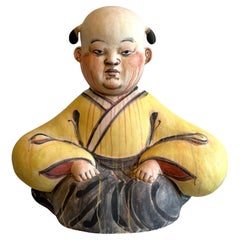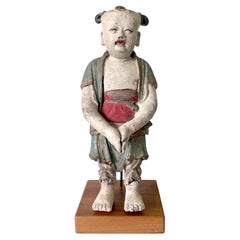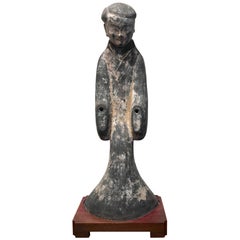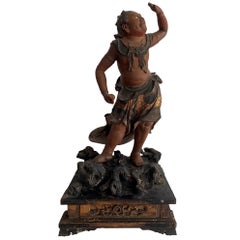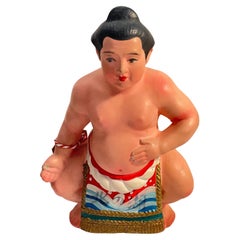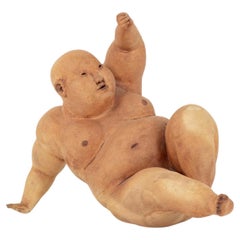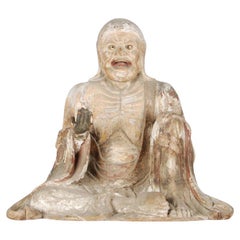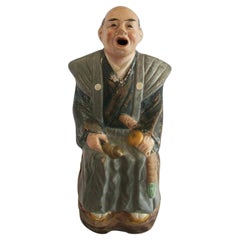Items Similar to Ceramic Figurative Sculpture by Akio Takamori Published
Want more images or videos?
Request additional images or videos from the seller
1 of 21
Ceramic Figurative Sculpture by Akio Takamori Published
$34,000
£25,675.44
€29,396.02
CA$48,016.89
A$52,422.95
CHF 27,483.21
MX$636,696.88
NOK 343,220.50
SEK 324,091.67
DKK 219,409.96
About the Item
A large figurative ceramic sculpture entitled by Akio Takamori (1950 - 2017) created in 2004. Stoneware with hand-painted surface, the sculpture depicts a half-naked standing boy figure with his hands in praying position. His berobed lower body, interestingly, morphed into a highly sculptural form. The scarlet color drapery with black stripes swells and coils into shapes that resembles breasts, echoing the statue's young age. The figure was apparently based on Prince Shotoku (574-622AD), a semi-legendary regent of the Asuka period who became a cult icon as the protector of Japanese nation, its imperial family and the Buddhism religion. Prince Shotoku has thence become a popular subject for art, depicted in both paintings and sculptures. The work is signed and dated inside the base as shown.
This piece was illustrated in the catalog "Between Clouds of Memory: Akio Takamori A mid-career survey" at Arizona State University Art Museum, Ceramics Research Center in 2005. See page 131 (shown in the last photo).
Akio Takamori is a Japanese born American ceramic artist. Born and raised in Japan, he spent the majority of his artistic career in the United States and is regarded as one of the most exciting and imaginative artists to emerge from the golden years of ceramics in the 1980s.
His work is in the permanent collection of many leading museums around the world, including the Carnegie Museum of Art, the Los Angeles County Museum of Art, the Museum of Arts and Design, the Nelson-Atkins Museum of Art, the Victoria and Albert Museum. His work, Alice with Rose, was acquired by the Smithsonian American Art Museum as part of the Renwick Gallery's 50th Anniversary Campaign. In 2000 the Racine Art Museum held a retrospective of his work. In 2022 the Vashon Center for the Arts held a retrospective of his work.
Quote from the catalog:
"After his signature "envelope" vessels of the 1980s, Takamori turned toward freestanding figures installed in distinctive groupings. These figurative sculptures deliver plain-spoken accounts of the artist's ongoing search for personal and cultural identity in an era of increasingly global influences and contradictions, bringing to the medium deep emotive and psychological connotations."
- Creator:Akio Takamori (Artist)
- Dimensions:Height: 33.5 in (85.09 cm)Width: 22 in (55.88 cm)Depth: 15 in (38.1 cm)
- Style:Modern (Of the Period)
- Materials and Techniques:
- Place of Origin:
- Period:
- Date of Manufacture:2004
- Condition:Wear consistent with age and use. Fine condition with minimal signs of wear. Surface was painted as intended per artist's practice.
- Seller Location:Atlanta, GA
- Reference Number:1stDibs: LU945038368512
Akio Takamori
Akio Takamori (1950 – January 11, 2017) was a Japanese-American ceramic sculptor and was a faculty member at the University of Washington in Seattle, Washington. Takamori was born in Nobeoka, Miyazaki, Japan in 1950 October 11. The son of an obstetrician/gynecologist who ran a clinic, Takamori was exposed to a wide range of people from an early age. At home, his father’s extensive library of both art and medical texts became a fascination for Takamori, who relished everything from Picasso reproductions to anatomical charts. Takamori’s interest in the arts persisted into early adulthood and upon his graduation from the Musashino Art College in 1971, he apprenticed to a master folk potter at Koishiwara, Fukuoka, Kyushu – Koishiwara ware. While learning the craft of industrial ceramics in a factory setting, he saw a traveling exhibition of contemporary ceramic art from Latin America, Canada, and the United States. Blown away by what he describes as the “antiauthoritarian” quality of the work, Takamori began to question his future as an industrial potter. When renowned American ceramist Ken Ferguson visited the pottery, the two had an immediate rapport and Ferguson encouraged Takamori go to the United States and study with him at the Kansas City Art Institute. In 1974 Takamori made the move to the United States, receiving his B.F.A. from the Kansas City Art Institute and later attending Alfred University in New York for his M.F.A. After working as a resident artist at the Archie Bray Foundation in Helena, Montana, he moved to Seattle, Washington in 1993, where he took his current teaching position as associate professor of the ceramics department. Takamori’s evolution as an artist began as he worked with Ferguson to break free of the constraints of industrial pottery and find new ways to express himself in clay. Since those first years at the Kansas City Art Institute his work has changed greatly, but it has always been figurative, based on the human body and expressive of human emotion and sensuality. In the 1980s, Takamori worked innovatively with the vessel form and its structure, creating flat envelope shaped pots formed from slabs. In the mid-1990s a visit to the European Ceramic Work Center in the Netherlands resulted in a shift from vessels back to an early interest in sculpture and the figure. Takamori created groupings of standing figural sculptures. The figures portray historical characters, contemporary society and rural villagers recalled from the artist's childhood in Japan. Most of Takamori’s work has been strongly influenced by his Japanese heritage. He has translated traditional Japanese prints into three-dimensional porcelain sculptures, he recreated his hometown in Japan from memory using clay, and he has translated Peter Bruegel’s paintings into sculptures of Japanese people. Takamori collaborated with Master Printer Mike Sims, of The Lawrence Lithography Workshop in Kansas City, Missouri, to create a series of prints that combine digital images of his ceramic sculptures with more traditional lithography printing techniques.
About the Seller
4.9
Platinum Seller
Premium sellers with a 4.7+ rating and 24-hour response times
Established in 2006
1stDibs seller since 2010
570 sales on 1stDibs
Typical response time: <1 hour
- ShippingRetrieving quote...Shipping from: Atlanta, GA
- Return Policy
Authenticity Guarantee
In the unlikely event there’s an issue with an item’s authenticity, contact us within 1 year for a full refund. DetailsMoney-Back Guarantee
If your item is not as described, is damaged in transit, or does not arrive, contact us within 7 days for a full refund. Details24-Hour Cancellation
You have a 24-hour grace period in which to reconsider your purchase, with no questions asked.Vetted Professional Sellers
Our world-class sellers must adhere to strict standards for service and quality, maintaining the integrity of our listings.Price-Match Guarantee
If you find that a seller listed the same item for a lower price elsewhere, we’ll match it.Trusted Global Delivery
Our best-in-class carrier network provides specialized shipping options worldwide, including custom delivery.More From This Seller
View AllImportant Ceramic Sculpture Karako by Akio Takamori Exhibited and Published
By Akio Takamori
Located in Atlanta, GA
Large figurative ceramic sculpture entitled "Karako" by Akio Takamori (1950 - 2017) created in 2005. Stoneware with hand-painted surface, the sculpture depicts a berobed boy in a sit...
Category
Early 2000s American Modern Figurative Sculptures
Materials
Ceramic
Rare Early Korean Buddhist Boy Attendant Figure Dongja Joseon Dyasty
Located in Atlanta, GA
A Korean statue of Dongja made from clay/stucco with wood core and painted with polychrome colors circa 18th century of the Joseon Dynasty. The statue is nicely presented on a custom...
Category
Antique 18th Century Korean Archaistic Sculptures and Carvings
Materials
Clay, Wood, Stucco
Tomb Lady in Waiting Figurine Han Dynasty
Located in Atlanta, GA
On offer is a pottery figurine of lady in waiting, found in the tombs as funeral objects in Han dynasty of China. Generally known as Han tomb ladies, t...
Category
Antique 15th Century and Earlier Chinese Han Ceramics
Materials
Pottery
Japanese Lacquered and Gilt Wood Buddhism Statue from Edo Period
Located in Atlanta, GA
An exceptional and wood statue of Buddhism Guardian Seitaka Doji from Japan circa Edo period (1603-1868), likely the earlier part of 17th century. One of two chief attendants of Fudou Myouou (the other being Kongara Doji), the name of Seitaka Doji is a transliteration of Sanskrit "Cetaka", meaning servant, slave, and he is said to personify expedient action. He is most commonly found on the right side of Fudou, together with Kongara Doji on the left, forming the Immovable triad, Fudou Sanzon, the terror of evil doers. Seitaka largely adheres to the iconography of a wrathful youth with fleshy body and face, skin in the color of a red lotus, has his hair tied in five knots, and holds a vajra in his left hand and a vajra-club in his right hand, but the actual artistic representations of him in Japan do...
Category
Antique 17th Century Japanese Japonisme Sculptures and Carvings
Materials
Metal
Chinese Stoneware Tomb Figure Han Dynasty
Located in Atlanta, GA
A Chinese molded stoneware figure on a custom display stand likely from Han Dynasty (202BC-220AD). These pottery figures were used as part of tomb accouterment for the burial practic...
Category
Antique 15th Century and Earlier Chinese Archaistic Ceramics
Materials
Stoneware
Antique Japanese Carved Village Buddha Enku Style
Located in Atlanta, GA
A carved wood buddha with lacquered surface in the style of Erku (1632–1695), a monk from Edo period who was famous for hand-carving Buddha statues in a primitive style. From a single wood block of what appears to be cedar, the standing buddha was carved in an unpolished manner with exposed knife strokes that effectively depicted a subtly smiling face and the folding of the cascading robes. The rustic style is full of Mingei charm being a great example of Japanese Buddhism...
Category
Antique 18th Century Japanese Edo Sculptures and Carvings
Materials
Wood
You May Also Like
Japanese Sumo Wresler KitanoUmi Figure Pottery 1980s
Located in Paris, FR
Dimensions: 7.5 x 12 x 18.5 cm
Material: Pottery
Name: Kitanoumi
Period: Showa (1980s)
Kitanoumi Toshimitsu (May 16, 1953 to November 20, 2015), born Toshimitsu Obata (Obata Toshi...
Category
Late 20th Century Japanese Showa Figurative Sculptures
Materials
Pottery
Esther Shimazu Signed Japanese Hawaiian American Male Sculpture
By Esther Shimazu
Located in Houston, TX
Esther Shimazu's bald and chunky male sculpture. She uses hand-built techniques to construct clay figures using colored slips, oxides when firing, then hand sands them and rubs in pi...
Category
21st Century and Contemporary Figurative Sculptures
Materials
Ceramic, Stoneware
Antique Japanese Statue of Datsue-ba or Shozuka No Baba, circa 14th C
Located in Prahran, Victoria
Japanese statue of Datsue-ba also known as Shozuka no Baba, Kamakura- Muromachi period.
Antique Japanese statue of Datsue-ba or Shozuka no B...
Category
Antique 15th Century and Earlier Japanese Other Sculptures
Materials
Cypress
$24,000 Sale Price
20% Off
Taoist Yixing Zisha Clay 'Scholar' Figure, Cold Painted, China, 20th Century
Located in Chatham, ON
Taoist Yixing Zisha clay 'priest or scholar' figure - cold painted - good detail - unsigned - China - 20th century.
Good vintage condition - chips and ...
Category
20th Century Chinese Chinese Export Ceramics
Materials
Clay, Paint
$1,050 Sale Price
30% Off
Esther Shimazu Signed Japanese Hawaiian American Female Sculpture
By Esther Shimazu
Located in Houston, TX
Esther Shimazu's bald female sculpture. She uses hand-built techniques to construct clay figures using colored slips, oxides when firing, then hand sands them and rubs in pigments to...
Category
20th Century Figurative Sculptures
Materials
Ceramic, Stoneware
A Japanese Carved Root Yōkai Figure, Meiji Period
Located in Savannah, GA
A japanese carved root yōkai figure, Meiji Period.
6 inches wide by 5 inches deep by 8 inches tall
Category
20th Century Japanese Figurative Sculptures
Materials
Wood
More Ways To Browse
American Ceramic Artists
Asuka Period
Antique Bacchus
Face Mask Sculpture
Hagenauer Wood
Iron Tree Sculpture
Italian Woman Nude
Lalique Car Mascots
Life Size Female Sculpture
Little Figurine
Male Athlete
Mechanical Sculpture
Murano Glass Pear
Nude Male 19th
Pineapple Sculpture
Plaster Torso
Reclining Nude Sculpture
Rodin Furniture
